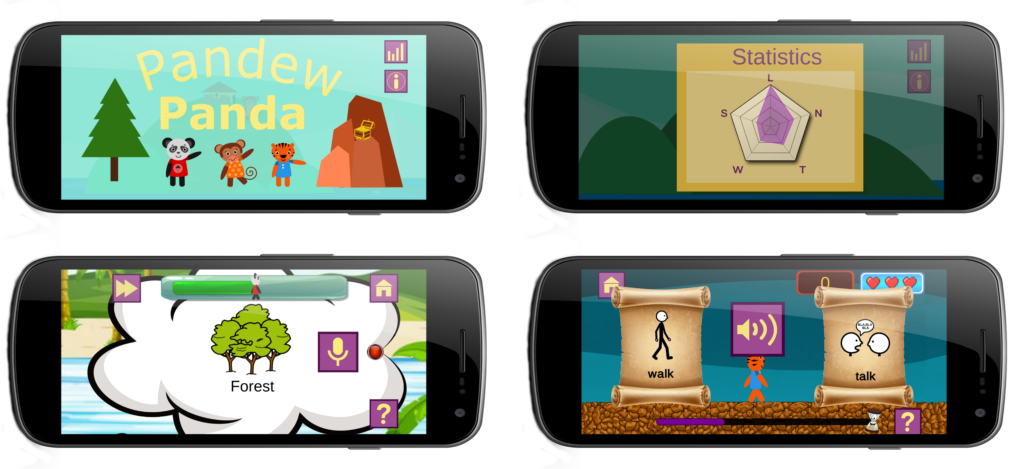Speech sound disorder (SSD) is a broad term covering all the disorders, as classified by Dodd [1]. The omission or substitution of a phoneme, which is a distinct sound that distinguishes one word from another, is a common occurrence in persons with SSD. Children especially may find a certain speech sound difficult to express not only in a particular word but in any occurrence of that precise sound. Much progress has been made on the subject of SSD treatment techniques such as the cycles approach and the minimal-pairs approach [2,3]. These advancements could be supported by technology in order to implement the techniques as affectively as possible, while also increasing the child’s motivation to practise. The involvement of technology in children’s learning has proved to be useful and effective when used correctly. Indeed, it has been noted that pupils making use of technological aids were very co-operative and active in the classroom [4]- [6]. Children and teenagers today are among the largest group of tablet and smartphone users, and it is had been predicted that children between the ages of 3and 4 will use mobile devices more extensively during their lives, than their parents would [7]. Furthermore, these studies show how mobile games are one of the main reasons why children use tablets and smartphones on a daily basis because of their evident appeal [7].
This study followed the development of an educational game to bridge the gap between technology, and speech and sound learning. The game was developed on both iOS and Android platforms and was tested on multiple devices, including tablets. The pupils’ native language was adopted in testing the functionality of the devices used for transforming the speech produced by the user into text. The written word resulting from the user’s speech was then compared with the word displayed. The game implements treatment techniques such as minimal pairs and the cycles approach.

Furthermore, it incorporates game development methods, such as providing constant feedback to the user and using a bright colour scheme [8]. The game also produced statistics for speech and language therapists in order to identify five phonemes with which the child was having the most difficulty. This study evaluates the effectiveness of an educational game in the field of speech production through the iterative process, and the evaluation meetings with speech and language therapists. This study also sought to assess the ability of the native-speech-to-text technology found in most mobile devices to be used for children with SSD. Qualitative data was gathered with the aid of a questionnaire, which provided two key findings. The first finding suggests that the use of an educational game was successful in motivating the children concerned in participating and to practise their speech. The second suggests that the native-speech-to-text technology could be quite difficult for a child with SSD to use, and therefore this technology could be further improved
upon to be more effective for children with SSD.
References/Bibliography:
[1] Dodd, B. (2014). Differential Diagnosis of Pediatric Speech Sound Disorder. Current Developmental Disorders Reports, 1(3), 189–196. https://doi.org/10.1007/s40474-014-0017-3
[2] Prezas RF, H. B. (210 C.E.). The cycles phonological remediation approach: Enhancing children’s phonological systems (M. R. Williams L, McLeod S (ed.)). Baltimore, MD: Brookes Publishing Company. pp. 137-158.
[3] Weiner, F. (1981). Treatment of phonological disability using the method of meaningful minimal contrast: two case studies. The Journal of Speech and Hearing Disorders, 46(1), 97– 103. https://doi.org/10.1044/jshd.4601.97
[4] Diemer, T. T., Fernandez, E., & Streepey, J. W. (2012). Student Perceptions of Classroom Engagement and Learning using iPads. Journal of Teaching and Learning with Technology, 1(2), 13–25.
[5] Chen, P. S. D., Lambert, A. D., & Guidry, K. R. (2010). Engaging online learners: The impact of Web-based learning technology on college student engagement. Computers and Education, 54(4), 1222–1232. https://doi.org/10.1016/j.compedu.2009.11.008
[6] Wario, R. D., Ireri, B. N., & De Wet, L. (2016). An Evaluation of iPad as a Learning Tool in Higher Education within a Rural Catchment: A Case Study at a South African University. Proceeding International Conferences ITS, ICEduTech and STE 2016 AN, 9. http://login.ezproxy1.lib.asu.edu/login?url=https://search.proquest.com/docview/1968427998? accountid=4485
[7] Markov, M., & Grigoriev, Y. G. (2013). Wi-Fi technology-an uncontrolled global experiment on the health of mankind.
[8] Electromagnetic Biology and Medicine, 32(2), 200–208. https://doi.org/10.3109/15368378.2013.776430
[9] Gee, J. P. (2008). Learning and games. The Ecology of Games: Connecting Youth, Games, and Learning, 21–40. https://doi. org/10.1162/dmal.9780262693646.021
Student: Kurt Camilleri
Course: B.Sc. IT (Hons.) Software Development
Supervisor: Dr. Lalit Garg
Co-supervisor: Dr. Peter Albert Xuereb
